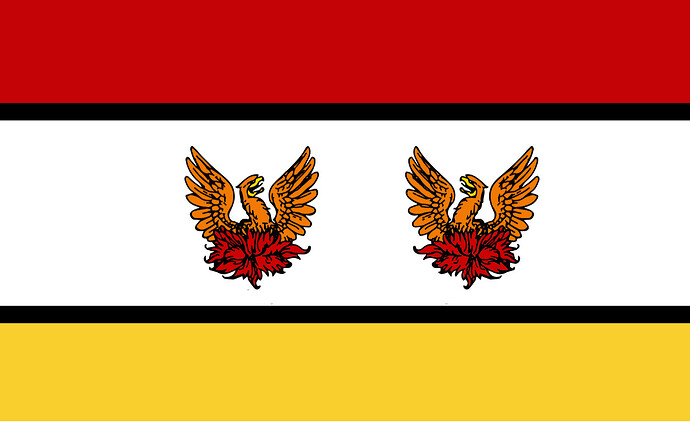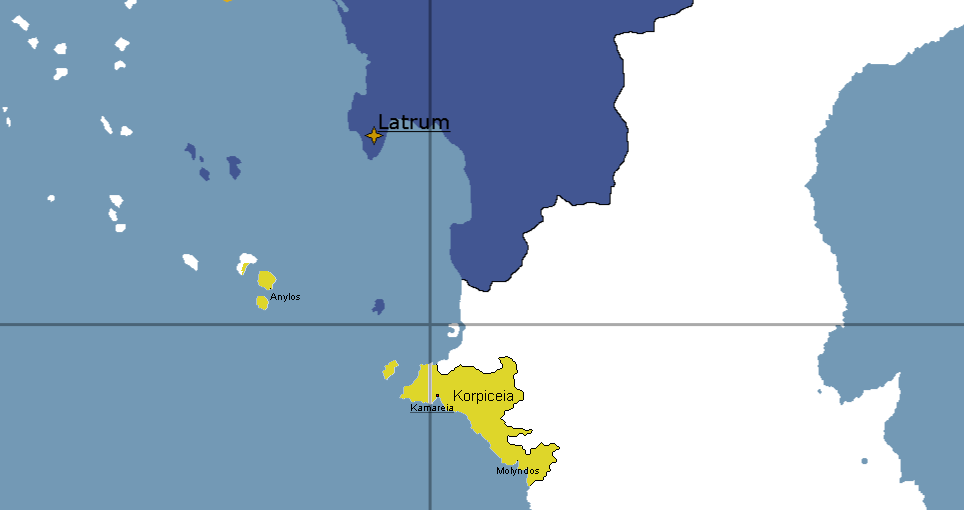Flag:
Nation Name (long): The Republic of Korpiceia
Nation Name (short): Korpiceia
Motto: By Justice and Liberty (Paldic: Από Δικαιοσύνη και Ελευθερία)
National Animal: Phoenix (fictional)
National Flower/Plant: Pine Tree
National Anthem: None yet
Capitol: Kamareia
Largest City: Kamareia
Demonym: Korpician
Language: Paldic (equivalent of greek) and its dialects, Xuhari
Species: Humans, Elves
Population: 4,233,678 (2020 Census)
Government type: Representative Direct Democracy (Parliamentary Republic with elements of Direct Democracy)
Leader(s): Prime Minister Alexios Pyrros
The entirety of the voting population
Legislature: The Parliament or through Popular Iniciative
Formation: 1827
Total GDP: 81,543,201,032$
GDP per capita: 19,261$
Currency: Korpician Dorata (KD)
Calling Code: +780
ISO 3166 code: KR, KOR
Internet TLD: .kor
Claim:
Historical Summary: The land of modern day Korpiceia used to be inhabited by Xuhari elves until their immigration towards the west of Gondwana (initially in today’s Crimpateia and then today’s Sayyed. Also, a very small minority still survives in the northwest of the country). The people who would become the modern day Korpicians came from a faraway land, as described by the legendary historian Kadmos, whose records seem valid, at about the 1300s. Kadmos says that the head of the Paldic Agon (head of Paldism, the religion that is still followed by the majority of Korpicians even nowadays) at the time, Seraphimos Nilos, sent a missionary expedition to roam the entirety of Urth for 15 years and then return and also claim any free land as property of the Agon. The missionaries did reach far and wide with little success, except for southwestern Gondwana where they would claim the lands to the north of Kamareia as sovereign estate of the Agon.
Because of its favourable climate and the geographical proximity to powerful nations such as Crimpateia and Sayyed the colony flourished. This little colony expanded to the southern coastline and by the 1600s two hundred thousand people resided in Korpiceia. The location of the Korpicians’ origin is unknown but, through estimations of older maritime records, it should be somewhere in eastern Novaris. We know that by the 1600s it had decayed and most probably been destroyed, a theory further supported by the fact that many Paldic-speaking people immigrated to Korpiceia at the time. The country’s industry was based heavily on trading, banking but agriculture as well, a tradition that has survived even to the present day. Until the 1780s the country was flourishing. The economy and population were experiencing an all time high in growth rate. The country expanded in to its modern day borders and many works of art (mainly in literature and music but painting and sculpting as well) were made in the period between 1650 and 1786.
In 1786 Maximos Polikratos, an authoritarian, nationalist and isolationalist political theorist and a Colonel of the Noble Korpician Armed Forces made a succesful coup attempt which would lead to him be in charge of the country until his death in 1819, replacing the previous regime of a liberal-leaning Merchant Republic. His policies of Autarky and socioeconomical isolation were detrimental for the country’s economy. Trade was almost totally discontinued and the exports made by Korpiceia were eliminated. The people had very little freedom and had to abide by martial law, bassically living under a constant regime of fear and suspicion. Polikratos died in 1819 leaving the country in a state of decadence. His son, Pamisos, took charge, and led the country until 1823 when the Great Korpician War for Freedom or simply the Korpician Revolution broke out. The revolution finished in 1827 with a death toll of about 60000 men, a horrible statistic for the country’s population before the war (four hundred and fifty thousand). The current political system was established and the people suddenly shifted to a regime of huge poltiical freedom, creating a huge new wave of artistic feats, also partly motivated by the hope created after the fall of the Polikratos state. The economy, on the contrary suffered, mostly due to mismanagement and the difficulty of passing laws and bills into effect because of the semi direct legislative system, as it continues to do so today, though in the last two decades the situation has become greatly better, leading to a surge in births and a steep fall in unemployment.
The political situation has been mild ever since, with only a few tensions arising with the proposals of highly controversial constitutional amendments which have almost all been vetoed by Popular Iniciative. Korpiceia is trying to recreate its banking and trading success that it used to enjoy, with moderate success, though right now, the conditions seem to be ideal for the reestablishment of the “Korpician Phoenix”, as the strong trading and bank based economy used to be nicknamed before the military coup.

